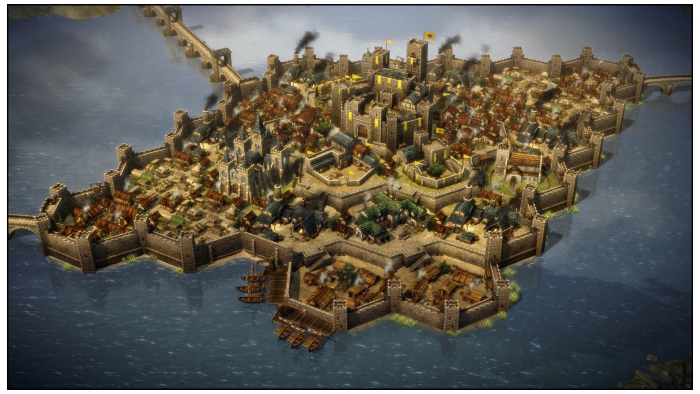Developers Blog 5
Dev Blog 5 – Shaping The Realm
The Realm in Total War Battles: KINGDOM is an ever changing environment. In our last Blog we explained how water works and today we’re shedding some light on terrain.
Players start the game with the same realm, but as soon as you start expanding your town and altering the land, you make it your own. There are a few things to consider when setting out to make your mark on the realm.
The first thing is that life in the realm carries on, even when you’re away. So your crops grow, the forest will reclaim the land, water will keep flowing and your livestock will wander to richer pastures (and might end up in one of your wheat fields). There’s also the ever present danger of Invaders and Raiders looting your land.
Not all of these things are affected by the terrain, but perhaps more than you think. So let’s have a closer look.
The terrain, has 5 different heights: Very high, high, medium, low and very low. You can dig trenches and pits or pile up hills as you please, as long as you have the required resources, but you have to follow a few rules when terraforming.
If you want to lower or raise a terrain tile, you have to make sure the surrounding tiles don’t differ in more than 1 height level. You can check a tiles terrain height by selecting it and then viewing the info panel. If the ‘Raise’ or ‘Lower’ terrain buttons are disabled, you can click on them to get a help message that explains why. Also, a tile needs to be cleared of trees, sheep, water, buildings, etc. before you can terraform it.
If you select the ‘Landscape’ tab and click tile which has been cleared, you will see a coloured overlay that indicates the different terrain levels in the tiles vicinity.
Now, you might be wondering why you’d want to change the terrain at all, it’ll all work perfectly fine the way it is. Of course, you could just leave the landscape be and try to build around it, but where’s the fun in that? Besides, not only do the different terrain heights bring certain restrictions, but the land affects the other dynamic elements as well.
Let’s talk about restrictions first. The most obvious example of this can be found when building settlements. Slums can only be built on very low or low terrain and they are also the only buildings which can be built on sand tiles. Houses may be constructed on low, medium or high terrain and Mansions on high or very high terrain. This is to reflect the tendency for wealthier people to live higher up, showing prosperity and status. Meanwhile, less fortunate town dwellers would live lower down. City buildings such as Churches, Blacksmiths, Barracks, etc. can be built on any terrain height.
If you want to connect your towns, you need to bear in mind that roads can only be built on medium height terrain, so you might have to dig a trench or two to reach your towns in the north of the realm. If you need to cross water, you also have bridges in your architectural arsenal.
So how does the terrain height effect the environment? In quite a few ways, and some more obvious than others.
The first thing that comes to mind is mining. To find stone, coal, silver and gold deposits, you have to dig and the deeper you dig, the more likely it is you’ll find the rarer deposits. Focussing your mining endeavours in the north of the map, where the terrain is higher, makes a lot of sense.
Remember though, to dig down one tile, the surrounding tiles can’t be higher than one level. So the deeper you dig, the more clear space you will need.
Your sheep and cattle also prefer different heights of terrain. Sheep prefer to move to grasslands that are uphill, while Cattle tend to go to lower areas.
If you don’t contain your livestock within the Sheep/Cattle Farm’s range, they might move too far away, in search of fresh pastures, for you to reach them.
Since your mining efforts will create a varied landscape, quarries can work quite well in tandem with both Sheep and Cattle Farms.
Finally, and perhaps a little less obvious, is the behaviour of propagating trees. The two tree types, pine and oak, have their individual pros and cons. While pine trees grow faster, they yield less wood when felled and conversely, oak trees take longer to grow, but provide more wood.
While you can build Woodcutters to plant trees, they will only propagate if they’re within two tiles of a water tile (or on Wetlands). On top of that, pine trees tend to propagate uphill and oak trees downhill. This is one reason why you find more oak trees in the south of the map than in the north.
If you were to experiment with Woodcutter placement to provide a steady yield of wood, you could use the terrain height to your advantage by raising or lowering the land to fit your requirements.
In the end, how much you wish to change the landscape of your realm is really down to your own preference and playstyle.
You might want to go wild and turn the land into an industrious state full of Mines and Farms that would make Saruman proud, or you just want to build a great looking Realm. Regardless, the power to do either lies in your hands.
Until next time, Keep it regal!





